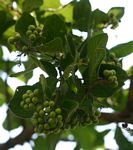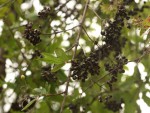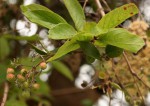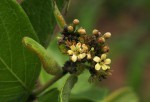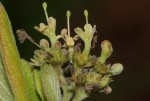Crossopteryx febrifuga
Selected images: Click on each image to see a larger version and details of the record View all images (25)
Photo: Bart Wursten
By path from Kopje Tops to Tingwa Raphia Palm Botanical Reserve, Mavhuradonha Wilderness Area
Detailed records: Display species records QDS maps by: Google Maps Point records by Google Maps
Species details: Click on each item to see an explanation of that item (Note: opens a new window)
| Synonyms: |
Rondeletia febrifuga Afzel. ex G. Don Tarenna mossambicensis Hiern |
| Common names: | Common crown-berry (English) Crystal-bark (English) Mubakatirwa (Shona) Mugoko (Shona) Mukombegwa (Shona) Mukombigo (Shona) Muteyo (Shona) Umphokophokwana (Ndebele) |
| Frequency: | Common |
| Status: | Native |
| Description: |
Shrub or small deciduous tree. Leaves opposite, elliptic to ovate, variously hairy or glabrous with conspicuous net-veining below. Flowers small, in dense terminal heads, creamy-white, sometimes tinged with pink. Fruit in clusters of ovoid capsules, crowned with the scars of the calyces. |
| Type location: |
Sierra Leone |
| Notes: | |
| Derivation of specific name: | febrifuga: referring to the use in traditional medicine to reduce fever. |
| Habitat: | In sandy soils in dry mixed woodland. |
| Altitude range: (metres) | Up to 1400 m |
| Flowering time: | Nov - Jan |
| Worldwide distribution: | From Ethiopia and Senegal, throughout much of tropical Africa, as far south as Limpopo, South Africa. |
| FZ divisions: | N,W,C,E,S |
| Growth form(s): | Tree. |
| Endemic status: | |
| Red data list status: | |
| Insects associated with this species: | |
| Spot characters: | Display spot characters for this species |
| Images last updated: | Friday 6 October 2017 |
| Literature: |
Bridson, D.M. & Verdcourt, B. (2003). Rubiaceae, Part 3 Flora Zambesiaca 5(3) Pages 626 - 628. (Includes a picture). Burrows, J.E., Burrows, S.M., Lötter, M.C. & Schmidt, E. (2018). Trees and Shrubs Mozambique Publishing Print Matters (Pty), Cape Town. Page 1016. (Includes a picture). Chapano, C. & Mamuto, M. (2003). Plants of the Chimanimani District National Herbarium and Botanic Garden, Zimbabwe Page 17. Chapano, C. & Mugarisanwa, N.H. (2003). Plants of the Matobo District National Herbarium and Botanic Garden, Zimbabwe Page 11. Coates Palgrave, K. (revised and updated by Meg Coates Palgrave) (2002). Trees of Southern Africa 3rd edition. Struik, South Africa Page 1038. Curtis, B.A. & Mannheimer, C.A. (2005). Tree Atlas of Namibia National Botanic Research Institute, Windhoek Page 610. Drummond, R.B. (1975). A list of trees, shrubs and woody climbers indigenous or naturalised in Rhodesia. Kirkia 10(1) Page 274. Mannheimer, C. & Curtis B. (2009). Le Roux and Müller's Field Guide to the Trees and Shrubs of Namibia Macmillan Education, Windhoek, Namibia. Pages 458 - 459. (Includes a picture). Mapaura, A. & Timberlake, J. (eds) (2004). A checklist of Zimbabwean vascular plants Southern African Botanical Diversity Network Report No. 33 Sabonet, Pretoria and Harare Page 72. Ntore, S. & al. (2024). Checklist of the vascular plants of Burundi Page 219. Pauwels, L. (1993). Nzayilu N'ti Guide des arbres et arbustes de la region de Kinshasa - Brazzaville Jardin Botanique National de Belgique, Bruxelles Page 193. (Includes a picture). Pickering, H. & Roe, E. (2009). Wild Flowers of the Victoria Falls Area Helen Pickering, London Page 102. (Includes a picture). Schmidt, E., Lötter, M. & McCleland, W. (2002). Trees and shrubs of Mpumalanga and Kruger National Park Jacana, Johannesburg, South Africa Pages 624 - 625. (Includes a picture). Setshogo, M.P. (2005). Preliminary checklist of the plants of Botswana. Sabonet Report no. 37. Sabonet, Pretoria and Gaborone Page 97. Strugnell, A.M. (2006). A Checklist of the Spermatophytes of Mount Mulanje, Malawi Scripta Botanica Belgica 34 National Botanic Garden of Belgium Page 162. Timberlake, J.R. & Childes, S.L. (2004). Biodiversity of the Four Corners Area: Technical Reviews Volume Two (Chapter 5-15) Appendix 5-1: Plant Checklist Occasional Publications in Biodiversity 15 Page 222. Van Wyk, B. & Van Wyk, P. (1997). Field Guide to Trees of Southern Africa. Struik, South Africa Pages 270 - 271. (Includes a picture). |
Other sources of information about Crossopteryx febrifuga:
Our websites:
Flora of Botswana: Crossopteryx febrifugaFlora of Burundi: Crossopteryx febrifuga
Flora of Caprivi: Crossopteryx febrifuga
Flora of the DRC: Crossopteryx febrifuga
Flora of Malawi: Crossopteryx febrifuga
Flora of Mozambique: Crossopteryx febrifuga
Flora of Rwanda: Crossopteryx febrifuga
Flora of Zambia: Crossopteryx febrifuga
External websites:
African Plants: A Photo Guide (Senckenberg): Crossopteryx febrifugaAfrican Plant Database: Crossopteryx febrifuga
BHL (Biodiversity Heritage Library): Crossopteryx febrifuga
EOL (Encyclopedia of Life): Crossopteryx febrifuga
GBIF (Global Biodiversity Information Facility): Crossopteryx febrifuga
Google: Web - Images - Scholar
iNaturalist: Crossopteryx febrifuga
IPNI (International Plant Names Index): Crossopteryx febrifuga
JSTOR Plant Science: Crossopteryx febrifuga
Mansfeld World Database of Agricultural and Horticultural Crops: Crossopteryx febrifuga
Plants of the World Online: Crossopteryx febrifuga
Tropicos: Crossopteryx febrifuga
Wikipedia: Crossopteryx febrifuga
